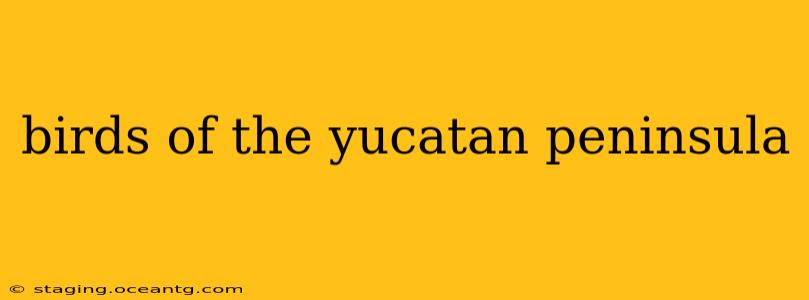The Yucatán Peninsula, a breathtaking region encompassing parts of Mexico, Belize, and Guatemala, is a haven for birdwatchers. Its diverse ecosystems, ranging from lush rainforests and sprawling mangroves to shimmering cenotes and sun-drenched coastlines, support a remarkable array of avian species. This vibrant region boasts a rich tapestry of birdlife, attracting both seasoned ornithologists and casual bird enthusiasts alike. Let's explore the fascinating avian world of the Yucatán Peninsula.
What are the most common birds in the Yucatán Peninsula?
Some of the most commonly sighted birds in the Yucatán Peninsula include the White-crowned Pigeon, a strikingly beautiful bird with its namesake crown and iridescent plumage; the Great Kiskadee, a bold and vocal flycatcher with a distinctive call; the Brown Pelican, a majestic seabird often seen soaring along the coast; and the Northern Mockingbird, renowned for its impressive vocalizations and mimicry skills. These are just a few examples; the peninsula's diverse habitats support a much wider variety.
What are some rare birds found in the Yucatán Peninsula?
While many species are common, the Yucatán Peninsula also holds the key to spotting some rarer avian treasures. The Harpy Eagle, a powerful apex predator, inhabits the region's remaining rainforests, though sightings are infrequent. Other rare or less frequently seen species include various hummingbirds endemic to the region, specific woodpecker species, and particular owl varieties that thrive in the peninsula's less-disturbed areas. Birdwatching tours often focus on helping enthusiasts locate these more elusive creatures.
What is the best time of year to go birdwatching in the Yucatán Peninsula?
The best time for birdwatching in the Yucatán Peninsula generally coincides with the migration seasons – spring and fall. During these periods, many North American migratory birds pass through, adding to the already impressive resident population. However, year-round birdwatching offers unique opportunities, as different species are active at different times of the year. Winter brings its own set of resident species in full display, while the breeding season (spring/summer) offers the chance to witness nesting behavior and vibrant courtship displays.
Where are the best places to go birdwatching in the Yucatán Peninsula?
The Yucatán Peninsula offers a variety of excellent birdwatching locations. Celestún Biosphere Reserve, known for its flamingos and diverse wetland birdlife, is a popular choice. Sian Ka'an Biosphere Reserve, a UNESCO World Heritage Site, boasts an incredible variety of habitats and bird species. The Calakmul Biosphere Reserve, a vast expanse of rainforest, is ideal for spotting more elusive species. Even urban areas like Mérida offer opportunities to observe common birds in parks and gardens. The key is choosing a location that aligns with the types of birds you're hoping to see – rainforest, coastal areas, or wetlands offer different avian experiences.
What kind of birds live in the Mayan ruins?
While the Mayan ruins themselves don't provide habitat in the same way forests do, they are frequently surrounded by vegetation that supports many bird species. You'll likely encounter many of the common birds mentioned earlier – such as the Northern Mockingbird and Great Kiskadee – adapting to the environment around the ancient structures. The ruins provide perching sites and opportunities to observe birds within a unique and historical landscape.
What birds are endangered in the Yucatán Peninsula?
Several bird species in the Yucatán Peninsula face threats from habitat loss, deforestation, and other human impacts. While precise lists of endangered species require detailed conservation reports, it's safe to say that the pressures faced by many global bird populations also impact the Yucatán. The best way to support the conservation of these birds is through supporting responsible tourism, advocating for habitat protection, and contributing to organizations dedicated to avian conservation in the region. Researching specific endangered species in the area before visiting will allow you to contribute to awareness and potential conservation efforts.
The Yucatán Peninsula's avian biodiversity is truly remarkable. By understanding the best times to visit, the ideal locations, and the challenges facing these wonderful creatures, you can contribute to their protection while experiencing the unforgettable beauty of this region's birdlife. Remember to always practice responsible birdwatching, respecting their natural habitats and avoiding disturbance.
